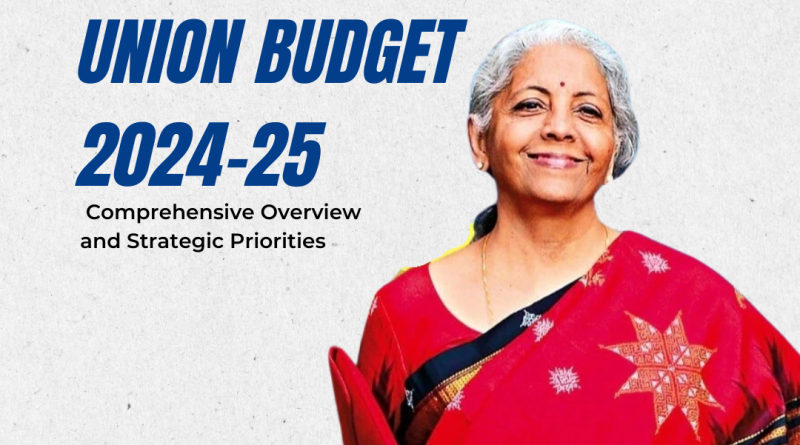In a pivotal presentation of the Union Budget 2024-25, Union Finance Minister Smt. Nirmala Sitharaman has outlined a robust plan to foster economic growth, support various sectors, and address key social issues. The budget emphasizes employment, skill development, support for MSMEs, and middle-class welfare while continuing to focus on inflation control and economic stability. Here’s a detailed breakdown of the budget highlights and priorities:
Part-A: Key Budget Highlights
Economic Overview
- Inflation Control: India’s inflation remains low and stable, trending towards the 4% target. Core inflation, excluding food and fuel, is at 3.1%. Measures are being taken to ensure that the supply of perishable goods is adequate to stabilize prices.
- Fiscal Deficit: The fiscal deficit stands at 4.9% of GDP, with an aim to reduce it to below 4.5% in the upcoming year.
- Economic Focus: The budget is strategically focused on employment, skilling, MSMEs, and support for the middle class.
Prime Minister’s Package for Employment and Skilling
A major component of the budget is the Prime Minister’s package, which includes five schemes designed to enhance employment opportunities and skill development for 4.1 crore youth over the next five years:
- Scheme A – First Timers: Provides a one-month salary of up to ₹15,000 in three installments to first-time employees registered with the Employees’ Provident Fund Organisation (EPFO).
- Scheme B – Job Creation in Manufacturing: Incentives for both employees and employers related to EPFO contributions during the initial four years of employment.
- Scheme C – Support to Employers: Reimburses up to ₹3,000 per month for two years towards EPFO contributions for each additional employee hired.
- New Centrally Sponsored Scheme for Skilling: Aims to skill 20 lakh youth over five years, with an upgrade of 1,000 Industrial Training Institutes (ITIs) and a new internship scheme for 1 crore youth in top 500 companies.
- Increased Loan Limits: Revision of the Model Skill Loan Scheme to offer loans up to ₹7.5 lakh and financial support for up to ₹10 lakh for higher education.
Budget Themes and Priorities
The budget centers on nine key priorities to drive India’s growth and development:
- Productivity and Resilience in Agriculture: ₹1.52 lakh crore allocated, with the release of 109 high-yielding and climate-resilient crop varieties. Initiatives include onboarding 1 crore farmers into natural farming and establishing 10,000 bio-input resource centers.
- Employment & Skilling: Includes the aforementioned Prime Minister’s package and a focus on increasing women’s participation in the workforce through hostels, crèches, and women-specific skilling programs.
- Inclusive Human Resource Development and Social Justice: Introduction of Purvodaya for industrial development in Eastern India, allocation of over ₹3 lakh crore for women and girls, and socio-economic development of 5 crore tribal people through the Pradhan Mantri Janjatiya Unnat Gram Abhiyan.
- Manufacturing & Services: Emphasis on expanding industrial capabilities and services sector growth.
- Urban Development: Provision of ₹10 lakh crore for PM Awas Yojana Urban 2.0 to address housing needs of 1 crore urban poor and middle-class families.
- Energy Security: Investment in energy infrastructure and clean energy initiatives.
- Infrastructure: Launch of Phase IV of PMGSY for all-weather connectivity to 25,000 rural habitations.
- Innovation, Research & Development: Focus on expanding the space economy with a venture capital fund of ₹1,000 crore.
- Next Generation Reforms: Continued focus on evolving policies and systems to support long-term growth and development.
Tax Reforms and Economic Incentives
- Income Tax Relief: Major relief for 4 crore salaried individuals and pensioners with an increased standard deduction from ₹50,000 to ₹75,000 and an increased deduction on family pensions from ₹15,000 to ₹25,000.
- Corporate Tax: Reduction of corporate tax on foreign companies from 40% to 35% and abolition of angel tax to boost start-ups and investments.
- TDS and Capital Gains: Reduction of TDS rates on various payments from 5% to 2% and an increase in the capital gains exemption limit to ₹1.25 lakh per year.
- Customs Duties: Reduction in customs duties on essential items such as x-ray panels, mobile phones, and precious metals, aimed at making these items more affordable.
- Rural and Regional Development
- Rural Development: Allocation of ₹2.66 lakh crore for rural development, including rural infrastructure.
- Regional Development: Formation of Purvodaya for all-round development in the Eastern region, covering states like Bihar, Jharkhand, West Bengal, Odisha, and Andhra Pradesh.
In Conclusion, The Union Budget 2024-25 presents a holistic approach to addressing India’s socio-economic challenges and leveraging opportunities for growth. By focusing on employment, skilling, support for MSMEs, and middle-class welfare, the budget aims to foster inclusive development while maintaining economic stability. The comprehensive measures and strategic investments outlined in the budget are poised to drive India’s growth trajectory, making it a key player on the global stage.


